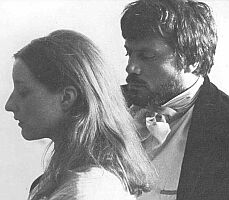Dante's Inferno (1967 film)
| Dante's Inferno | |
|---|---|
 Judith Paris as Lizzie Siddal and Oliver Reed as Rossetti. | |
| Genre | Costume drama |
| Written by | Austin Frazer |
| Directed by | Ken Russell |
| Starring | Oliver Reed Judith Paris Andrew Faulds Iza Teller Christopher Logue |
| Country of origin | United Kingdom |
| Original language(s) | English |
| No. of episodes | 1 |
| Production | |
| Producer(s) | Ken Russell |
| Running time | 90 minutes |
| Release | |
| Original network | BBC1 |
| Original release | 22 December 1967 |
Dante's Inferno: The Private Life of Dante Gabriel Rossetti, Poet and Painter (1967) is a feature-length 35mm film directed by Ken Russell and first screened on the BBC on 22 December 1967 as part of Omnibus. It quickly became a staple in cinemas in retrospectives of Russell's work. Using nonlinear narrative technique, it tells of the relationship between the 19th-century artist and poet Dante Gabriel Rossetti and his model, Elizabeth Siddal.[1]
Plot[edit]
The exhumation of Lizzie Siddal's desiccated body is seen, followed by a shot of Rossetti dancing among the flames of a bonfire of paintings by Reynolds and Gainsborough. A voice-over informs us that Rossetti is a founder of a revolutionary group of artists called the Pre-Raphaelite Brotherhood. The figure of the young Lizzie dressed as Joan of Arc appears above the flames.
Lizzie is seen modelling for Millais' Ophelia and for a painting of Joan by Rossetti. The voice-over states that she eats little and often throws it up. She and Rossetti spend several years together while he paints and draws her, but she spurns his sexual advances, even slashing him with a needle when he presses himself on her. Rossetti turns to the more accommodating Fanny Cornforth.
Lizzie is introduced to laudanum by Emma Brown to alleviate her stomach pain. She is advised by Christina Rossetti that Dante Gabriel needs a patron. Christina's voice-over speaks her poem In an Artist's Studio, about Lizzie. She tells Lizzie she looks ill. Rossetti and Christina visit William Holman Hunt, who is painting The Light of the World. Hunt asks Rossetti to look after his girlfriend Annie Miller while he is away in the Holy Land painting The Scapegoat, but Rossetti has an affair with her and Hunt spurns her on his return. John Ruskin visits Rossetti's studio and shows an interest in Lizzie's art.
Rossetti meets Edward Burne-Jones and William Morris in Oxford and encounters the beautiful Jane Burden. They paint the Oxford Union murals. Jane marries Morris and Rossetti marries Lizzie. Lizzie becomes increasingly hysterical due to her laudanum use and Rossetti's philandering. She dies from an overdose. Rossetti buries his unpublished poems with her.
Some years later, Charles Augustus Howell persuades him to dig the poems up, but Rossetti is haunted by the image of the dead Lizzie and becomes addicted to chloral. Fanny Cornforth rescues him from a suicide attempt, but Rossetti is now increasingly obsessed with Morris' wife Jane. He sleeps with her when Morris is away in Iceland, but she remains distant. Isolated, with only the loyal Fanny to care for him, Rossetti sinks further into addiction.

DANTISAMOR.WORDPRESS.COM
Pre-Raphaelites on Film: Ken Russell’s ‘Dante’s Inferno’ (1967)
The British director Ken Russell’s documentary-style biopic of Dante Gab
